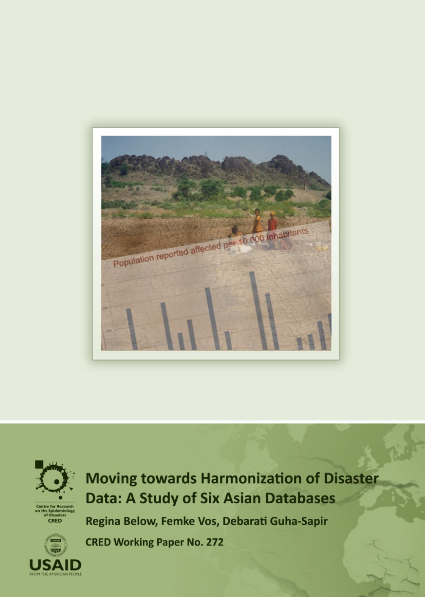
With disaster events increasing in magnitude and frequency, the need for disaster impact data collection and sharing is both urgent and continuous in the effort to save lives, alleviate suffering, and reduce economic losses. The systematic collection of information related to the frequency and impact of disasters is an important tool for governments, international policy setting organizations and institutions in charge of relief and recovery activities. Sponsored by USAID/OFDA, and in the context of the Global Risk Identification Program (GRIP) of the United Nations Development Program (UNDP) framework, CRED coordinates a collaboration activity focused on national disaster data compilation initiatives. The collaboration aims at the sharing of knowledge to enhance the visibility, accessibility, and applicability of disaster databases. By providing technical support, the project contributes to strengthening the standardization, reliability, and use of existing methodological and operational approaches. A more complete and accurate collection of data on disaster occurrence and impact will ensure better risk estimations and improve the availability of information and analysis on disaster risks and risk factors. The strengthening of disaster databases will eventually serve the global, international, and national humanitarian communities involved in disaster response planning and risk reduction. The Asian region has historically faced many challenges from disasters and remains nowadays the area most prone to natural disasters. Many initiatives aim at disaster preparedness and reduction in Asia, and among these are invaluable local disaster data compilation initiatives that support the information management of disasters at the local and international levels. In the current study, six Asian national disaster databases were selected, located in Bangladesh, Indonesia, Nepal, Philippines, Sri Lanka and Vietnam. Of these six databases, three have been developed using a standalone methodology1, and the remaining three are based on the DesInventar methodology2. Based on the literature, CRED has developed a framework to capture the quality of disaster loss databases. In this framework, database quality not only is reflected in the correctness of the data but also encompasses other aspects such as database accessibility, serviceability, credibility of the database hosting institute, database methodology, and accuracy and reliability of the data. Prerequisites for maintaining a disaster database, such as the institutional environment and sustainable resources, form the basis of developing and maintaining a disaster database and are included in the framework. A preliminary report was developed in collaboration with the 6 database hosting institutes, describing the general structure and present functioning of each disaster database. Next, case studies were performed, including on-site interviews and discussions focused on the methodological and operational procedures of the database and on identification of database strengths and weaknesses. This activity led to tailored recommendations for strengthening the databases. Next, a comparison of the global EM-DAT database and the national disaster databases was performed to study their similarities, differences, and completeness. Based on these activities, guidelines were established for the development of disaster databases and the compilation of reliable data to serve disaster data initiatives and the humanitarian community worldwide. The effectiveness of disaster preparedness and prevention depends on the evidence base on which the programme is anchored. Equally important, disaster data is central to studies that link disasters to health, social systems, poverty or even climate change. While there is a growing recognition of the need for accurate and comparable data on the impacts of disasters, there is still much room for improvement. Since many years, CRED has persevered in its efforts to improve the quality of data on human impacts of disasters, engaging in many methodological initiatives with collaborators. Today, with new and cheaper technologies, information on the human impact of disasters should be systematically recorded and harmonized for comparisons across regions and also against time. Most importantly, we have realized that to design a framework to improve data quality, we needed to get down in the weeds and examine the way in which countries actually operate. We did not want to work towards a solution without a sound grasp of the issues faced by our national colleagues. We conclude from our study that there is an urgent need for robust field methodologies to estimate the number of dead, injured, and affected and guidelines for their use by national governments, international policy setting organizations and relief agencies. Ambiguity in figures that encompass an unspecified variety of groups or conditions, a common problem in disaster impact reporting, significantly reduces the usability of the data. We strongly advocate the development of standard methodologies that every agency can use to prevent ambiguous data from becoming a source of misguided policy and erroneous decision-making.
